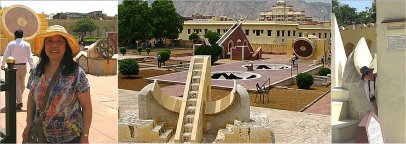The Jantar Mantar ("Magical Device") Observatory Monument
of Jaipur is a collection of nineteen architectural
astronomical instruments, built by the Rajput king Sawai Jai Singh, and
completed in 1734 CE. The monument features masonry, stone and brass instruments
that were built using astronomy and instrument design principles of ancient
Hindu Sanskrit texts. The instruments allow the observation of astronomical
positions with the naked eye.
Jantar Mantar is one of the largest stone observatories
in the world which is still running. It stands witness to the wisdom of
the former age. The sundial has a time accuracy of two seconds!
The monument expresses architectural innovations, as well as the coming
together of ideas from different religious and social beliefs in 18th century
India. The observatory is an example of the Ptolemaic positional astronomy
which was shared by many civilizations.
The monument features instruments operating in each of
the three main classical celestial coordinate systems: the horizon-zenith
local system, the equatorial system and the ecliptic system. The observatory
consists of nineteen instruments for measuring time, predicting eclipses,
tracking location of major stars as the earth orbits around the sun, ascertaining
the declinations of planets, and determining the celestial altitudes and
related ephemerides. Ref: Wikipedia.
The instruments are:
-
Chakra Yantra (four semicircular arcs on which a gnomon
casts a shadow, thereby giving the declination of the Sun at four specified
times of the day. This data corresponds to noon at four observatories around
the world (Greenwich in UK, Zurich in Switzerland, Notke in Japan and Saitchen
in the Pacific); this is equivalent of a wall of clocks registering local
times in different parts of the world.)
-
Dakshin Bhitti Yantra (measures meridian, altitude
and zenith distances of celestial bodies)
-
Digamsha Yantra (a pillar in the middle of two concentric
outer circles, used to measure azimuth of the sun, and to calculate the
time of sunrise and sunset forecasts)
-
Dhruva Darshak Pattika (observe and find the location
of pole star with respect to other celestial bodies)
-
Jai Prakash Yantra (a two hemispherical bowl-based
sundial with marked marble slabs that map inverted image of sky and allows
the observer to move inside the instrument, measures altitudes, azimuths,
hour angles and declinations)
-
Kapala Yantra (measures coordinates of celestial bodies
in azimuth and equatorial systems, any point in sky can be visually transformed
from one coordinate system to another)
-
Kranti Vritta Yantra (measures longitude and latitude
of celestial bodies)
-
Laghu Samrat Yantra (the smaller sundial at the monument,
inclined at 27 degrees, to measure time, less accurate than Vrihat Samrat
Yantra)
-
Nadi Valaya Yantra (two sundials on different faces
of the instrument, the two faces represent north and south hemispheres,
the accuracy of the instrument in measuring the time is less than a minute)
-
Rama Yantra (a double cylinder instrument that measures
azimuth and altitudes of celestial bodies)
-
Rasi Valaya Yantra (12 gnomon dials that measure ecliptic
coordinates of stars, planets and all 12 constellation systems)
-
Shastansh Yantra (next to Vrihat Samrat Yantra, this
instrument is a 60 degree arc built in the meridian plane within a dark
chamber. At noon, the sun's pinhole image falls on a scale below enabling
the observer to measure the zenith distance, declination, and the diameter
of the Sun.)
-
Unnatasha Yantra (a metal ring divided into four segments
by horizontal and vertical lines, with a hole in the middle; the position
and orientation of the instrument allows measurement of the altitude of
celestial bodies)
-
Vrihat Samrat Yantra (world's largest gnomon sundial,
measures time in intervals of 2 seconds using shadow cast from the sunlight)
-
Yantra Raj Yantra (a 2.43-metre bronze astrolabe,
one of the largest in the world, used only once a year, calculates the
Hindu calendar)
-
Plus: Disha Yantra ~ Kanali Yantra ~ Misra Yantra ~ Palbha
Yantra
|




























